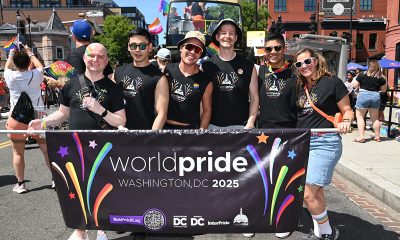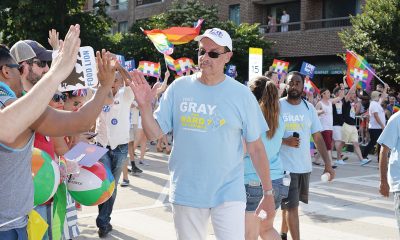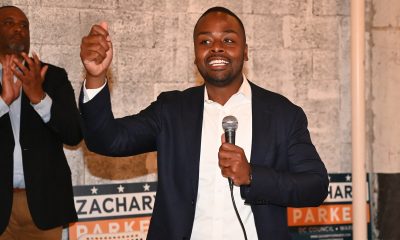Local
Catania, Graham breeze to victory; 7 gays win in Md.
Fenty write-in votes high in gay precincts
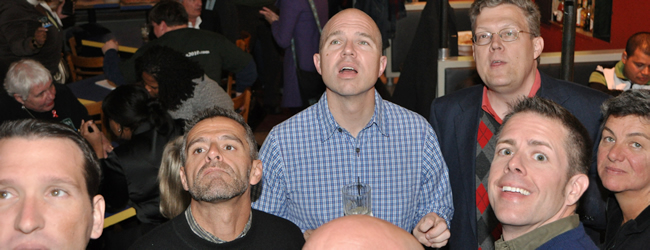
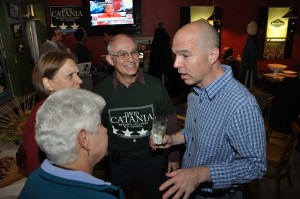
David Catania's re-election to D.C. Council was one of the few bright spots on an Election Day widely regarded as a disaster for gay rights. (Blade photo by Michael Key)
Pro-gay D.C. Council Chair Vincent Gray won his race for mayor with 73.9 percent of the vote and gay Council members David Catania (I-At-Large) and Jim Graham (D-Ward 1) easily won re-election Tuesday.
But an unauthorized write-in campaign for Mayor Adrian Fenty, who lost the Democratic mayoral nomination to Gray in the Sept. 14 primary, yielded high write-in vote counts in nearly all voter precincts with a high concentration of gay residents.
In Maryland, the number of out gay or lesbian members of the state legislature increased from four to seven in Tuesday’s election. Among the winners is Mary Washington, who captured a House of Delegates seat from Baltimore to become the first black lesbian to win a seat in the Maryland Legislature and the second to hold that distinction in the nation.
The “write-in” category in the D.C. mayor’s race won in at least two precincts with high concentrations of gays on Capitol Hill, highlighting the same racial divisions among voters that surfaced in the primary, where Gray won in majority black sections of the city and Fenty won in majority white areas.
Most of the gay precincts are in majority white sections, such as Dupont Circle, Adams Morgan, Logan Circle and Capitol Hill. Activists familiar with the LGBT community have said black gays, like their straight counterparts, supported Gray in overwhelming numbers. But because they are dispersed throughout the city and not concentrated in gay enclaves, like those in the mostly white areas, there are no known “black gay” precincts.
“I don’t think those are anti-Gray votes as much as they are pro-Fenty votes,” Catania said on Wednesday. “I think the vast majority of them, after the inauguration, those very same people will be very receptive to Vince and his message, and we’re all going to come back together.”
In his victory speech late Tuesday night at Love nightclub in Northeast D.C., which once hosted the city’s black LGBT Pride festival, Gray reiterated his campaign theme of “one city,” saying his administration will work hard to build unity among D.C.’s diverse population groups.
Most of the city’s LGBT activist leaders joined the Gertrude Stein Democratic Club, the city’s largest LGBT political group, in backing Gray in the mayoral race.
Gray captured 73.9 percent of the citywide vote, with the “write-in” vote coming in second with 22.8 percent. However, in majority white Wards 1, 2, 3, and 6, the margin between the Gray and write-in vote was closer, with the write-in vote count rising to between 30 and 43 percent. In Precincts 89 and 90 on Capitol Hill, which are home to a sizable gay population, the write-in vote came to 50.3 percent and 50.5 percent respectively, with Gray receiving 46.3 percent and 45.5 percent.
In the majority black Wards 4, 5, 7, and 8, the write-in vote fell to single digits.
D.C. Board of Elections and Ethics executive director Pokey Suleman said the city’s election law bars the board from identifying the names of people receiving write-in votes unless they capture enough votes to win the race. Most election observers assume the vast majority of write-in votes in Tuesday’s mayoral election went to Fenty.
“I would presume that the majority is for Fenty but I would not presume all of them are,” Suleman said.
In the at-large Council race, Catania came in second behind Council member Phil Mendelson (D-At-Large) in a four-candidate contest where the highest two vote-getters win the seats. Mendelson, who has a strong record of support on gay issues, and Catania endorsed each other.
Mendelson received 58.3 percent, with Catania receiving 30.9 percent of the vote. Both came out far ahead of challenger David Schwartzman, the Statehood-Green Party candidate who supports LGBT equality; and anti-gay independent candidate Richard Urban, who called for repeal of the city’s same-sex marriage law. Schwartzman received 6.8 percent and Urban received 5.1 percent. Non-Democratic candidates who win at-large seats traditionally have received less votes than the Democratic candidate in a city where the overwhelming majority of voters register as Democrats.
In the Ward 1 Council race, Graham received 81.3 percent of the vote compared to his gay Republican challenger, Marc Morgan, who received 7.6 percent of the vote. Statehood-Green Party candidate Nancy Shia received 9.5 percent.
Ward 5 Council candidate Tim Day, who became the fourth out gay candidate running for a D.C. Council seat this year, lost to incumbent Council member Harry Thomas, a Democrat, by a lopsided margin of 84.0 percent to 5.9 percent.
Day received the endorsement of the Washington Post. He drew additional news media coverage by disclosing IRS and D.C. corporation office records showing that a charitable constituent group that Thomas had been operating for many years did not have a tax exemption from the IRS and lost its corporate status from the city. The Post criticized Thomas over his handling of the charitable group. But the flap over the group did not help Day, an accountant, garner much support from voters.
Thomas has been a supporter of LGBT rights and voted for the same-sex marriage law, triggering organized opposition to his candidacy from church groups and the anti-gay National Organization for Marriage.
LGBT activists called the effort by some local religious leaders to target all Council members up for election this year because of their support for the same-sex marriage bill a total failure.
“In the end, it wasn’t the contentious issue that the opponents predicted,” said Mendelson, who also was targeted for his support for the gay marriage bill. “I can’t tell you how many candidate forums I went to where the issue of marriage equality did not come up,” he said.
“It’s striking that the opposition to marriage equality never got any traction in this election in spite of their intense rhetoric,” he said.
In the Maryland election, incumbent state Sen. Richard Madaleno of District 18 in Montgomery County won re-election with 74.5 percent of the vote.
House of Delegates incumbents Anne Kaiser (District 14), which includes Silver Spring, Olney, and Damascus; Heather Mizeur (District 20), which includes parts of Silver Spring and Takoma Park; and Maggie McIntosh (District 43), which includes parts of Baltimore, each won re-election by comfortable margins.
Washington, who ran in District 43, which has three seats, came in third with 31.6 percent of the vote. The highest three vote-getters win House of Delegates seats in most districts, which have three seats per district.
The other out gay or lesbian challengers who won on Tuesday were Luke Clippinger (District 46), which includes parts of Baltimore; and Bonnie Cullison (District 19), which includes parts of Montgomery County.
Most gay ANC candidates win races
Twenty-four of the 29 D.C Advisory Neighborhood Commission candidates identified by the Gertrude Stein Democratic Club as gay or lesbian or allies of the LGBT community won their races Tuesday. Fourteen of the winners are incumbents.
Three incumbents lost their seats in what observers called unexpected wins by their challengers. Among them were longtime ANC 6D07 Commissioner Robert “Bob” Siegel, who lost his Washington Nationals Stadium area seat to challenger David Garber. Garber had the endorsement of Council member Tommy Wells (D-Ward 6). In Ward 5, gay ANC 5C07 Commissioner Barrie Daneker lost to challenger James Fournier.
Gay incumbent Michael Patterson in ANC District 6B09 lost to challenger Brian Flahaven.
Following is a list of the ANC candidates, both incumbents and challengers, listed by the Stein Club as members or allies of the LGBT community. Candidates marked by an asterisk indicate they are either leading or trailing, and the final outcome won’t be determined until absentee and challenged ballots are counted.
Juan Lopez (1B07)—won
Bill O’Field (1C02)—lost
Mike Feldstein (2B01)—won
Jack Jacobson (2B04)–won
Victor Wexler (2B05)—won
Mike Silverstein (2B06)—won
Phil Carney (2B07)—won
Ramon Estrada (2B09)—leading by 39 votes*
Alexander “Alex” Padro (2C01)—won
Michael Benardo (2F06)—won
Lee Brian Reba (3C01)—won
Tom Smith (3D02)—won
Bob Summersgill (3F07)—won
Michael Yates (4C01)—won
Joseph Martin (4C09)—won
Thalia Wiggins (5B06)—won
Mary Lois Farmer-Allen (5C06)—won
Barrie Daneker (5C07)—lost
Adam Healy (6A01)—won
Neil Glick (6B08)—leading by 9 votes*
Michael Patterson (6B09)—lost
Larry Frankel (6B10)—lost
Brian Cox (6C05)—trailing by 13 votes*
Bill Crews (6C07)—won
Andy Litsky (6D04)—won
Roger Moffatt (6D05)—won
Robert “Bob” Siegel (6D07)—lost
Zina Williams (7B02)—won
Catherine Woods (7C03)—won
Maryland
Silver Spring holds annual Pride In The Plaza
‘Today means inclusion. It means to build resilience’
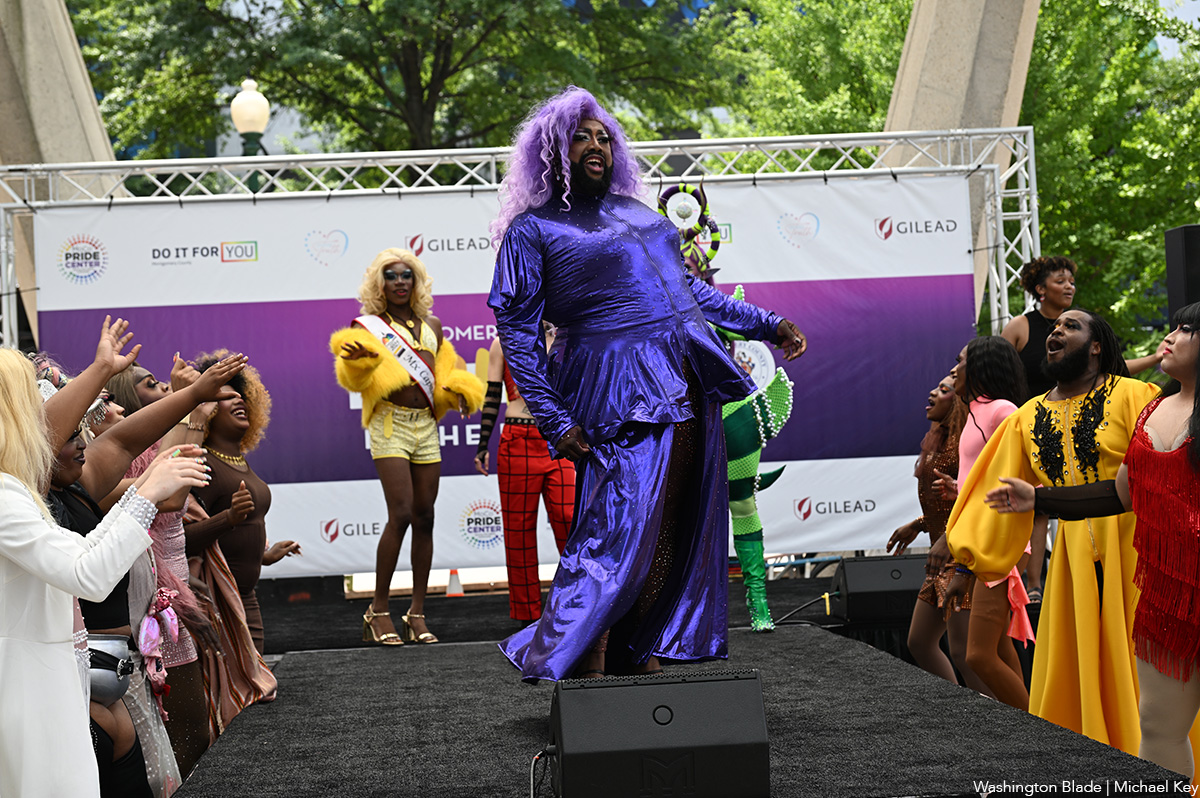
Silver Spring’s annual Pride in the Plaza event took place on Sunday to celebrate the LGBTQ community and emphasize inclusion and resilience.
“Today means inclusion. It means to build resilience, love,” Robyn Woods, program and outreach director for Live In Your Truth, which organized the event, said. “I mean, just being surrounded by the community and so many great entrepreneurs, business owners, and just being a part of this whole rainbow coalition that we call the LGBTQIA to be about.”
With the event being her first time organizing for Live In Your Truth, Woods said she felt emotional to see the support and love at the event.
“Some people (are) bringing out their children, their babies, their grandparents,” Woods said. “It’s a lot more allies here than anything else. That type of support to me means so much more than just support from my community; just outside support, inside support, so much support around it, so much love. Everyone’s smiling outside, helping each other.”
Attendees of the event were able to head over to the Family Fun Zone, an air-conditioned Pride Cool Down Lounge, or watch live drag performances in the main stage area.
Along with entertainment and a shaved-ice stand, rows of information tables stood along the plaza, including FreeState Justice, the Washington Spirit, Trans Maryland, Moco Pride Center, and the Heartwood Program, an organization that offers support, therapy, education, and resources to the LGBTQ community.
“I want people to know about our services, and I love what we have to offer,” Jessica Simon, psychotherapist for Heartwood Program’s Gender Wellness Clinic, said. “I (also) want to be part of a celebration with the community, and so it feels good to be here with other people who have something they want to give to the community.”
She added that within today’s political climate, to which she called an “antidote to shame,” it’s important to be celebrating Pride.
“There’s a lot of demonization of LGBTQI people,” Siena Iacuvazzi, facilitator for Maryland Trans Unity, said. “(Pride) is part of the healing process.”
Iacuvazzi said she was taught to be ashamed of who she was growing up, but being a part of a community helped her flourish in the future.
“I was taught how to hate myself. I was taught that I was an abomination to God,” she said. “But being a community is like understanding that there are people who have experienced the same thing, and they’re flourishing. They’re flourishing because they’re willing to stand up for themselves as human beings and discover themselves and understand what’s true for themselves.”
She added that Pride allows for a mutual understanding to take place.
“It’s more of a sense of belonging … and just taking that home and understanding you’re not alone,” Iacuvazzi said. “We’re each taking our own journey — we’re not putting that on each other. It’s just walking away with a sense of belonging and humanity.”
Similar to Iacuvazzi, Woods said she hopes attendees’ biggest takeaways would be family, fun, resilience, and pride.
“Being proud of yourself, being happy for who you are, and representation and how much it matters,” she continued. “And I think all these young people that are walking around here get to see versions of themselves, but older. They get to see so many different lesbian, gay, bisexual, pansexual people that are successful, that are showing love, that care, and it’s not how we’re portrayed in the media. It’s lovely to see it out here. (It’s) like we’re one big old, happy family.”
Virginia
Spanberger touts equality, reproductive rights in Arlington
Democratic Va. gubernatorial nominee made campaign stop at Freddie’s Beach Bar
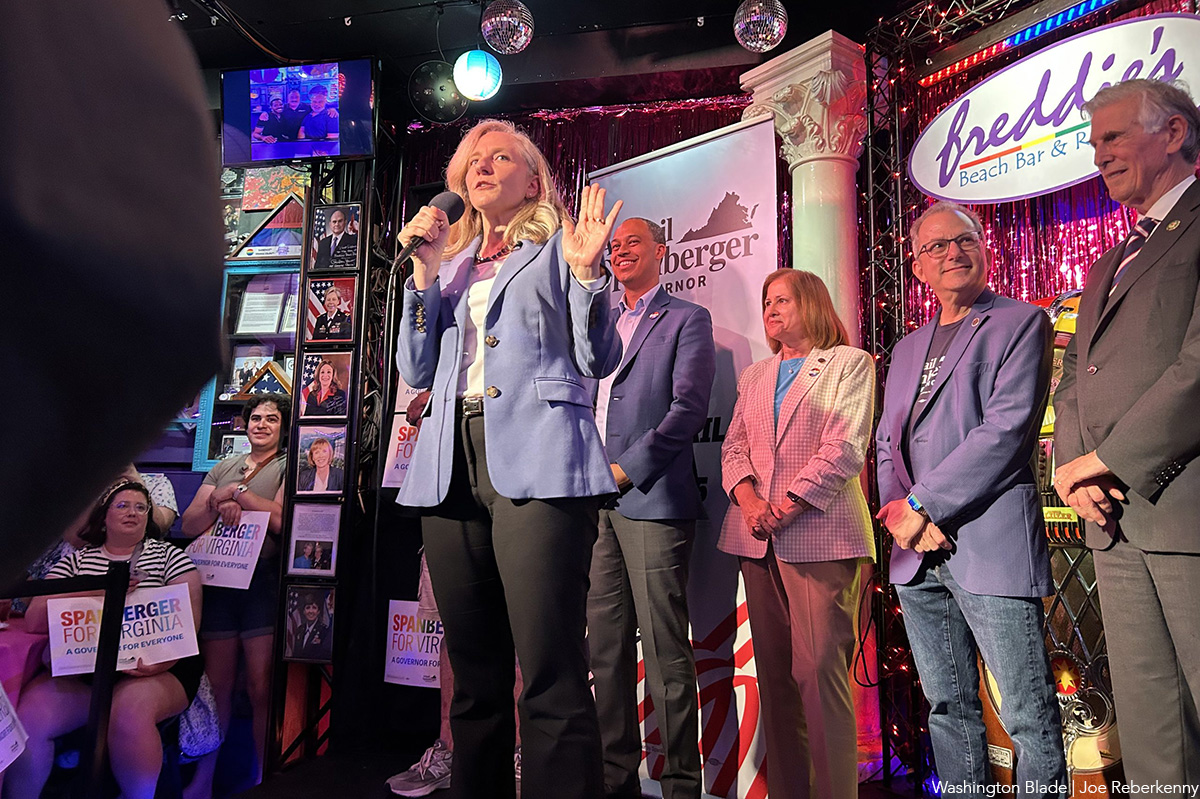
With the general election heating up and LGBTQ rights under increasing threat nationwide, Virginia gubernatorial candidate Abigail Spanberger brought her “Span Virginia Bus Tour” to Arlington’s Freddie’s Beach Bar for a campaign stop filled with cheers, policy pledges, and community spirit.
Spanberger, who served three terms in the U.S. House of Representatives from 2019 through early 2025 for Virginia’s 7th Congressional District, also served as a federal law enforcement officer specializing in narcotics and money laundering cases, and as a CIA case officer working on counterterrorism and nuclear counterproliferation.
Spanberger is running against Republican nominee Winsome Earle-Sears, the current lieutenant governor of Virginia, who said she was “morally opposed” to a bill protecting marriage equality in the commonwealth.
She was joined by other Democratic candidates and supporters: lieutenant gubernatorial candidate Ghazala Hashmi, attorney general candidate Jay Jones, Virginia state Sen. Adam Ebbin (D-Alexandria), and Congressman Don Beyer.
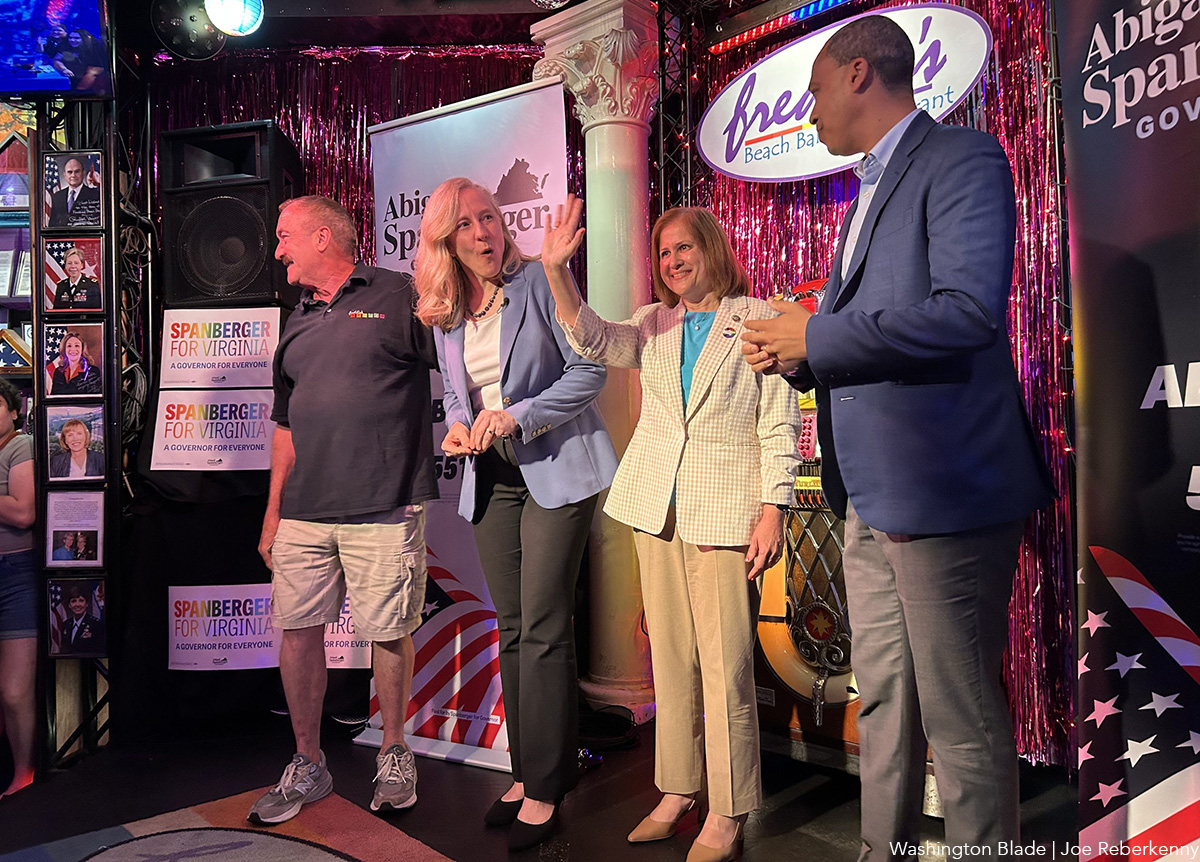
Freddie’s was packed wall-to-wall with supporters, many of whom wore “Spanberger for Virginia” shirts in the progressive Pride flag colors. In her speech, she made it clear that LGBTQ Virginians’ rights are on the ballot this year.
“I’m so excited to be here, and I am so grateful to the entire staff of Freddy’s for letting us overtake this incredible venue that is not just an awesome place to come together in community, but is a symbol to so many people of joy, of happiness, of community and of celebrating our friends and our neighbors,” Spanberger told the packed restaurant. “It is exciting to be here, and particularly during this Pride month, and particularly as we reflect on the 10-year anniversary of Obergefell and the reality that we still have so much work to do.”
“The reality is there are so many people who still would be inclined to take us backwards,” she said. “In this moment when we see attacks on people’s rights, on people’s humanity, on Virginia, on our economy, on research, on public education, on food security, on health care, on Virginians, on their jobs, on public service and on people — it can get heavy.”
“What it does for me is it makes me want to double down, because once upon a time, when I was talking to my mother about some horror show or sequence of activities coming out of a particular administration, she did not really have the patience to listen to me and said ‘Abigail, let your rage fuel you’ — and the conversation was over. And so I reflect on that, because, in fact, every day there is so much fuel to be had in this world and in this moment.”
One of the points Spanberger continued to emphasize was the importance of steadfast state government officials following the election of President Donald Trump, which has led to rollbacks of LGBTQ and bodily autonomy rights as a result of the conservative-majority U.S. Supreme Court.
“What the past few years have shown us is that a Supreme Court decision, no matter how many years we have celebrated its existence, does not protect us in the long term. And so as governor, I will work to make sure that every protection we can put in place for the dignity, the value, and the equal rights of all Virginians is a priority.”
During her speech, Spanberger highlighted several of the key values driving her campaign — protecting reproductive freedom and human rights, lowering healthcare costs, safeguarding Virginia’s environment, and ensuring that public education is affordable, accessible, and rooted in truth, not politics.
Spanberger went as far as to say that she wants to amend the state’s constitution to remove Section 15-A. “The reality is that in Virginia, we still have a ban in our state constitution on marriage equality. It is of the utmost urgency that we move forward with our constitutional amendment.”
“We will work to ensure that that terrible constitutional amendment, that was put in years ago, is taken out and updated and ensuring that Virginia is reflective in our most essential documents of who we are as a commonwealth, which is an accepting place that celebrates the vibrancy of every single person and recognizes that all Virginians have a place, both in that constitution and in law,” she added.
Following the event, two supporters spoke to the Washington Blade about why they had come out to support Spanberger.
“I came out because I needed to show support for this ticket, because it has been a particularly rough week, but a long few years for our rights in this country, in this state, with this governor, and it’s — we need to flip it around, because queer people need protection,” said Samantha Perez, who lives in Ballston. “Trans people need protection. Trans kids need protection. And it’s not gonna happen with who’s in Richmond right now, and we just need to get it turned around.”
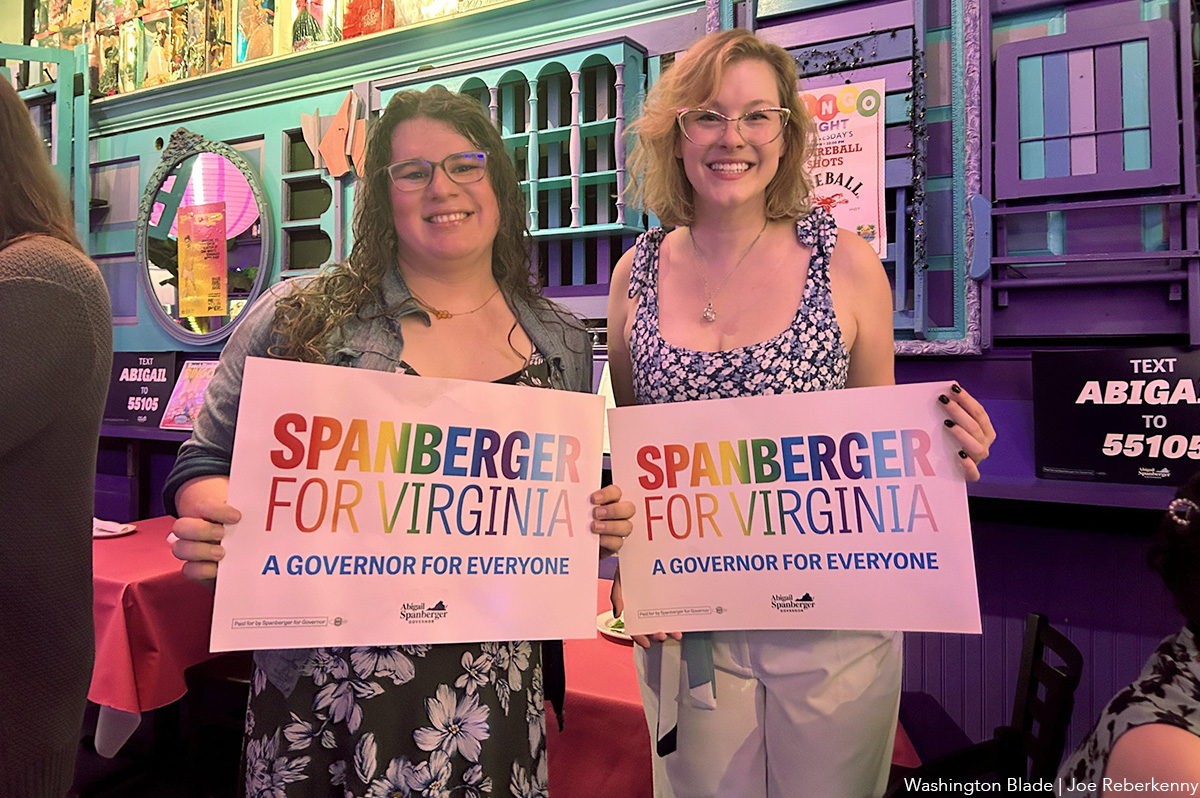
“The whole neighborhood’s here. All our friends are here,” said Annie Styles of Pentagon City. “It means the world to me to take care of each other. That’s what a good community does. That’s not what we’ve had with the Republicans here or across the nation for a really long time. It’s time to show that care. It’s time to make sure that good people are in a position to do good things.”
District of Columbia
Activists protest outside Hungarian Embassy in DC
Budapest Pride scheduled to take place Saturday, despite ban
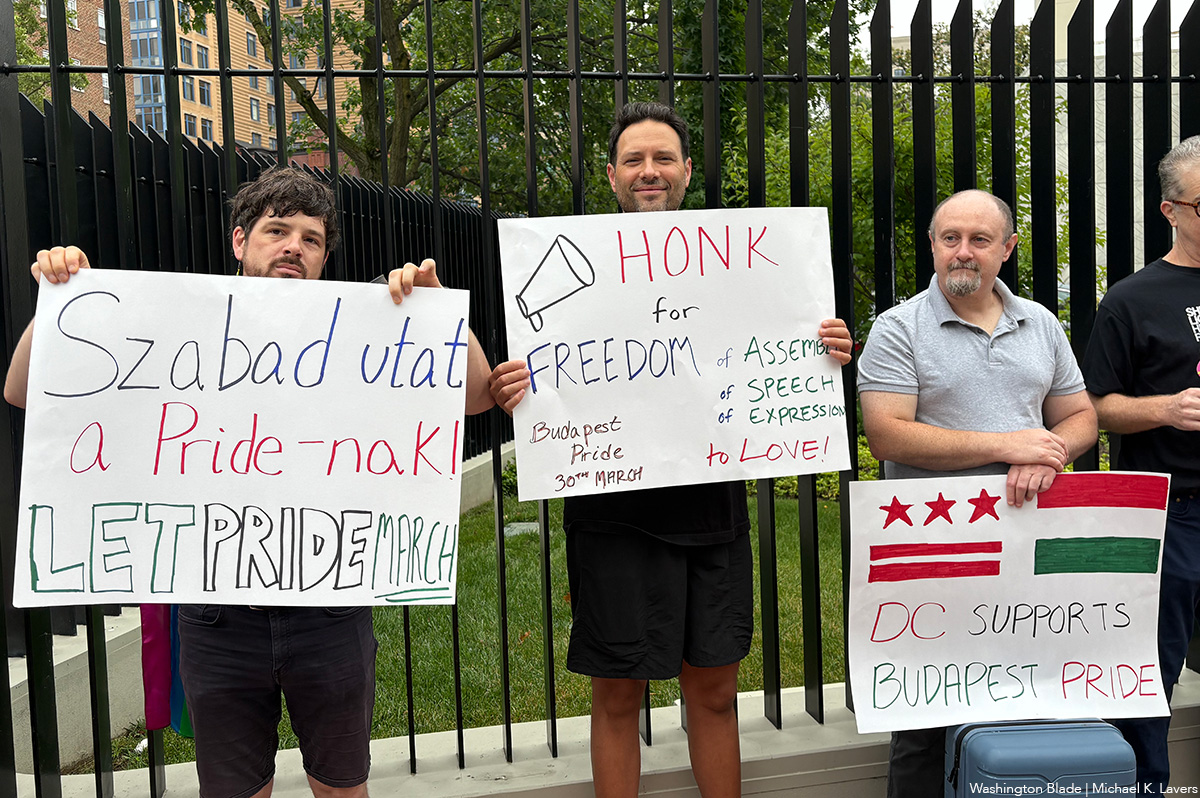
More than two dozen activists gathered in front of the Hungarian Embassy in D.C. on Friday to protest the country’s ban on Budapest Pride and other LGBTQ-specific events.
Amnesty International USA Executive Director Paul O’Brien read a letter that Dávid Vig, executive director of Amnesty International Hungary, wrote.
“For 30 years Budapest Pride has been a celebration of hope, courage, and love,” said Vig in the letter that O’Brien read. “Each march through the streets of Budapest has been a powerful testament to the resilience of those who dare to demand equality, but a new law threatens to erase Pride and silence everyone who demands equal rights for LGBTI people.”
“The Hungarian government’s relentless campaign against LGBTI rights represents a worrying trend that can spread normalizing division and hatred,” added Vig. “Thank you for standing with us when we refuse to be intimidated.”
Council for Global Equality Chair Mark Bromley and two of his colleagues — Stephen Leonelli and Keifer Buckingham — also spoke. Health GAP Executive Director Asia Russell and Chloe Schwenke, a political appointee in the Obama-Biden administration who worked for the U.S. Agency for International Development, and Planned Parenthood staffers are among those who attended the protest.
(Washington Blade video by Michael K. Lavers)
Hungarian lawmakers in March passed a bill that bans Pride events and allow authorities to use facial recognition technology to identify those who participate in them. MPs in April amended the Hungarian constitution to ban public LGBTQ events.
Budapest Pride is scheduled to take place on Saturday, despite the ban. Hundreds of European lawmakers are expected to participate.
“Sending strength to the patriotic Hungarians marching tomorrow to advance human dignity and fundamental rights in a country they love,” said David Pressman, the gay former U.S. Ambassador to Hungary, on Friday on social media.
Sending strength to the patriotic Hungarians marching tomorrow to advance human dignity and fundamental rights in a country they love. Szabadság és szerelem. My past remarks on Budapest Pride: https://t.co/y1QhA9QouA
— David Pressman (@AmbPressman) June 27, 2025
-

 U.S. Supreme Court3 days ago
U.S. Supreme Court3 days agoSupreme Court upholds ACA rule that makes PrEP, other preventative care free
-

 U.S. Supreme Court4 days ago
U.S. Supreme Court4 days agoSupreme Court rules parents must have option to opt children out of LGBTQ-specific lessons
-

 National5 days ago
National5 days agoEvan Wolfson on the 10-year legacy of marriage equality
-
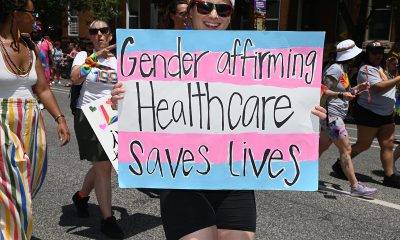
 Congress4 days ago
Congress4 days agoSenate parliamentarian orders removal of gender-affirming care ban from GOP reconciliation bill

